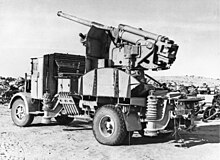
The 8.8 cm Flak 18/36/37/41 is a German 88 mm anti-aircraft and anti-tank artillery gun, developed in the 1930s. It was widely used by Germany throughout World War II and is one of the most recognized German weapons of the conflict. The gun was universally known as the Acht-acht ("eight-eight") by the Germans and the "eighty-eight" by the Allies. Due to its lethality, especially as a tank killer, the eighty-eight was greatly feared by Allied soldiers.

The cannone da 65/17 modello 13 was an artillery piece developed by Italy for use with its mountain and infantry units. The designation means 65 mm calibre gun, barrel length 17 calibres, which entered service in 1913. The designation is often shortened to cannone da 65/17.

Vittorio Veneto was the second member of the Littorio-class battleship that served in the Italian Regia Marina during World War II. The ship's keel was laid down in October 1934, launched in July 1937, and readied for service with the Italian fleet by August 1940. She was named after the Italian victory at Vittorio Veneto during World War I, and she had three sister ships: Littorio, Roma, and Impero, though only Littorio and Roma were completed during the war. She was armed with a main battery of nine 381-millimeter (15.0 in) guns in three triple turrets, and could steam at a speed of 30 knots.

Littorio was the lead ship of her class of battleship; she served in the Italian Regia Marina during World War II. She was named after the Lictor, in ancient times the bearer of the Roman fasces, which was adopted as the symbol of Italian Fascism. Littorio and her sister Vittorio Veneto were built in response to the French battleships Dunkerque and Strasbourg. They were Italy's first modern battleships, and the first 35,000-ton capital ships of any nation to be laid down under the terms of the Washington Naval Treaty. Littorio was laid down in October 1934, launched in August 1937, and completed in May 1940.

The Littorio class, also known as the Vittorio Veneto class, was a class of battleship of the Regia Marina, the Italian navy. The class was composed of four ships—Littorio, Vittorio Veneto, Roma, and Impero—but only the first three ships of the class were completed. Built between 1934 and 1942, they were the most modern battleships used by Italy during World War II. They were developed in response to the French Dunkerque-class battleships, and were armed with 381-millimeter (15 in) guns and had a top speed of 30 knots. The class's design was considered by the Spanish Navy, but the outbreak of World War II interrupted construction plans.

The Cannone da 75/46 C.A. modello 34 was a mobile Italian anti-aircraft gun used during World War II. The designation means it had a caliber of 75 mm, the barrel was 46 caliber-lengths long and it was accepted in service in 1934.
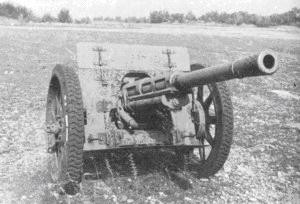
The Cannone da 75/32 modello 37 was an Italian field gun used during World War II. The designation indicates that the gun had a 75 mm caliber, the barrel was 32 caliber-lengths long and it was accepted for service in 1937.
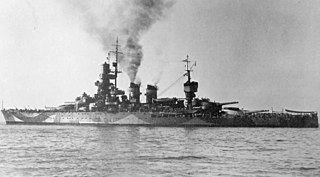
The Andrea Doria class was a pair of dreadnought battleships built for the Royal Italian Navy between 1912 and 1916. The two ships—Andrea Doria and Duilio—were completed during World War I. The class was an incremental improvement over the preceding Conte di Cavour class. Like the earlier ships, Andrea Doria and Duilio were armed with a main battery of thirteen 305-millimeter (12 in) guns.
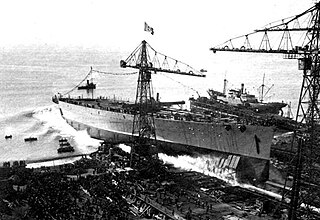
Impero was the fourth Littorio-class battleship built for Italy's Regia Marina during the Second World War. She was named after the Italian word for "empire", in this case referring to the newly (1936) conquered Italian Empire in East Africa as a result of the Second Italo-Abyssinian War. She was constructed under the order of the 1938 Naval Expansion Program, along with her sister ship Roma.

The Breda 20/65 mod.35, also simply known as 20 mm Breda or Breda Model 35, among other variations, was an Italian 20 mm (0.787 in) anti-aircraft gun produced by the Società Italiana Ernesto Breda of Brescia company during the 1930s and early 1940s. It saw heavy usage during the Spanish Civil War and World War II, among other conflicts. It was designed in 1932 and adopted by the Italian armed forces in 1935, becoming one of two major 20 mm caliber anti-aircraft guns used by Italy during World War II, along with the Scotti-Isotta Fraschini 20/70, both of which fired the Swiss 20x138mmB "Solothurn Long" cartridge.

The Cannone da 152/45 modello 1911 was an Italian naval gun built by the Ansaldo company. It formed the secondary armament of the two Andrea Doria-class dreadnought battleships built during World War I. A number of guns were also converted to siege artillery and coastal artillery roles and served during both world wars.

The Mirabello-class were a group of three destroyers built for the Regia Marina during World War I. Carlo Alberto Racchia was sunk by a mine in the Black Sea during the Allied intervention in the Russian Civil War in 1920. The remaining two ships, obsolescent by 1938, were re-rated as destroyers and participated in World War II. Carlo Mirabello was also lost to a mine while escorting a convoy in 1941. The last surviving ship, Augusto Riboty, was reconfigured as a convoy escort in 1942–1943. The torpedo tubes were removed and depth charges and 20 mm (0.79 in) anti-aircraft guns added. She survived the war and was supposed to be transferred to the Soviet Union as war reparations in 1946, but she was obsolescent so money was accepted instead, and she remained in the italian navy until the early 1950s. The ship was scrapped five years later.

The Cannone da 381/50 Ansaldo M1934 was a 381-millimeter (15 in), 50-caliber naval gun designed and built for the Royal Italian Navy by Gio. Ansaldo & C. in the 1930s. The gun served as the main armament of Italy's last battleships, the Littorio class. These built-up guns consisted of a liner, a cylinder over the chamber and part of the rifle bore, a full-length cylinder, and a 3/4 length jacket with a hydro-pneumatically operated side-swinging Welin breech block. 40 barrels were produced in total by Ansaldo and O.T.O., but none survive to this day. Each battleship carried nine guns mounted in three triple turrets with maximum elevation of 35°. Time between salvos was approximately 45 seconds.
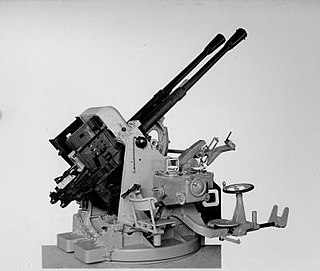
The Cannone-Mitragliera da 37/54 (Breda) was a 37 mm (1.5 in) automatic anti-aircraft gun produced by the Breda company in Italy.
The Cannone da 135/45 OTO 1937 was a 135 mm (5.3 in) 45-caliber naval gun built for the Regia Marina in the late 1930s. Built as a response to the French Canon de 138 mm Modèle 1929, it was meant to have the same range as the widespread 120 mm gun, but with less muzzle velocity and less dispersion.

The Cannon 76/40 Model 1916 was a widely used naval gun on ships of the Royal Italian Navy during World War I and World War II. A very versatile weapon, it was used as primary, secondary and tertiary armament on a number of ship classes, while other ship classes had a shortened version of it, the Cannon 76/30 Model 1915. After being replaced aboard ships of the Royal Italian Navy it saw widespread use on land in a number of different roles such as coastal artillery, anti-aircraft gun and railroad gun during World War II.
The Cannone da 76/45 S 1911 was a naval gun used by Italy during World War I and World War II. In addition to its naval role it was also employed in coastal artillery, railway gun and anti-aircraft roles.

